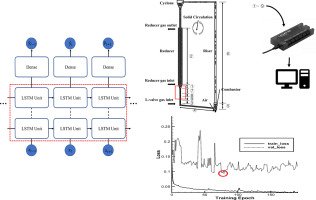当前位置:
X-MOL 学术
›
Powder Technol.
›
论文详情
Our official English website, www.x-mol.net, welcomes your
feedback! (Note: you will need to create a separate account there.)
Recurrent neural network based detection of faults caused by particle attrition in chemical looping systems
Powder Technology ( IF 4.5 ) Pub Date : 2020-05-01 , DOI: 10.1016/j.powtec.2020.03.038 Jianhua Pan , Yaswanth Pottimurthy , Dawei Wang , Soohwan Hwang , Shalin Patil , Liang-Shih Fan
Powder Technology ( IF 4.5 ) Pub Date : 2020-05-01 , DOI: 10.1016/j.powtec.2020.03.038 Jianhua Pan , Yaswanth Pottimurthy , Dawei Wang , Soohwan Hwang , Shalin Patil , Liang-Shih Fan

|
Abstract Chemical looping is a novel and promising technology that converts fossil fuels to electricity and high value chemicals with in-situ carbon capture without significant cost penalties. Smooth and controlled solid circulation is the key to the successful operation of the chemical looping system. Bridging or arching, which may occur in the moving bed standpipe of the system, caused by a combination of fines accumulation and gas flows, is a major impediment to the smooth solid circulation and can lead to the failure of the entire system operation. Thus, early detection of the tendency of bridging or arching is important. This paper describes a model that applies the long short-term memory based recurrent neural network scheme to detect the tendency of arching in the standpipe of a chemical looping system. The arching tendency can be ascertained by early detection of the bubble formation in the standpipe. The bubble movement or local fluidization is recognized to precede the arching formation due to local accumulation of fine particles generated from coarse particle attrition. The early detection of the bubbles thus renders it possible to prevent arching through the prompt action of fines removal from the system. In this study, the recurrent neural network model which detects the fines induced fault manifested as bubbles in the standpipe is developed. It is over the data generated from an experimental sub-pilot scale, cold-flow chemical looping unit. To improve the robustness of the diagnosis, a number of networks with different structures are considered, and an ensemble decision strategy is used to conduct the diagnosis. The recall value obtained of the diagnosed result, which represents the extent of the fraction of real bubbles that are detected, can reach higher than 86.7%. This result reflects a good accuracy of the recurrent neural network model in the fault detection for the chemical looping system.
中文翻译:

基于循环神经网络的化学循环系统中由粒子磨损引起的故障检测
摘要 化学循环是一种新颖且有前景的技术,可通过原位碳捕获将化石燃料转化为电能和高价值化学品,而不会产生显着的成本损失。平稳可控的固体循环是化学循环系统成功运行的关键。系统的移动床立管中可能发生的桥接或拱起,由细粒堆积和气体流动共同引起,是固体顺利循环的主要障碍,并可能导致整个系统运行的故障。 ? ? ? ? ? ? ? ? ? ? ? ? ? ? ? ? ? ? ? ? ? ? ? ? ? ? ? ? ? ? ? ? ? ? ? ? ? ? ? ? ? ? ? ? ? ? ? ? ? ? ? ? ? ? ? ? ? ? ? ? ? ? ? ? ? ? ? ? ? ? ? ? ? ? ? ? ? ? ? ? 因此,早期发现桥接或拱起的趋势很重要。本文描述了一个模型,该模型应用基于长短期记忆的递归神经网络方案来检测化学循环系统立管中的拱形趋势。拱形趋势可以通过早期检测立管中的气泡形成来确定。由于粗颗粒磨损产生的细颗粒的局部积累,气泡运动或局部流化被认为先于拱形形成。因此,气泡的早期检测使得通过从系统中去除细粉的迅速动作来防止拱起成为可能。在这项研究中,开发了一种循环神经网络模型,该模型检测细粉引起的故障,表现为竖管中的气泡。它超过了从实验性子中试规模、冷流化学循环装置生成的数据。为了提高诊断的鲁棒性,考虑了多个不同结构的网络,并使用集成决策策略进行诊断。诊断结果得到的召回值,代表检测到的真实气泡的比例,可以达到86.7%以上。该结果反映了循环神经网络模型在化学循环系统故障检测中的良好准确性。
更新日期:2020-05-01
中文翻译:

基于循环神经网络的化学循环系统中由粒子磨损引起的故障检测
摘要 化学循环是一种新颖且有前景的技术,可通过原位碳捕获将化石燃料转化为电能和高价值化学品,而不会产生显着的成本损失。平稳可控的固体循环是化学循环系统成功运行的关键。系统的移动床立管中可能发生的桥接或拱起,由细粒堆积和气体流动共同引起,是固体顺利循环的主要障碍,并可能导致整个系统运行的故障。 ? ? ? ? ? ? ? ? ? ? ? ? ? ? ? ? ? ? ? ? ? ? ? ? ? ? ? ? ? ? ? ? ? ? ? ? ? ? ? ? ? ? ? ? ? ? ? ? ? ? ? ? ? ? ? ? ? ? ? ? ? ? ? ? ? ? ? ? ? ? ? ? ? ? ? ? ? ? ? ? 因此,早期发现桥接或拱起的趋势很重要。本文描述了一个模型,该模型应用基于长短期记忆的递归神经网络方案来检测化学循环系统立管中的拱形趋势。拱形趋势可以通过早期检测立管中的气泡形成来确定。由于粗颗粒磨损产生的细颗粒的局部积累,气泡运动或局部流化被认为先于拱形形成。因此,气泡的早期检测使得通过从系统中去除细粉的迅速动作来防止拱起成为可能。在这项研究中,开发了一种循环神经网络模型,该模型检测细粉引起的故障,表现为竖管中的气泡。它超过了从实验性子中试规模、冷流化学循环装置生成的数据。为了提高诊断的鲁棒性,考虑了多个不同结构的网络,并使用集成决策策略进行诊断。诊断结果得到的召回值,代表检测到的真实气泡的比例,可以达到86.7%以上。该结果反映了循环神经网络模型在化学循环系统故障检测中的良好准确性。











































 京公网安备 11010802027423号
京公网安备 11010802027423号